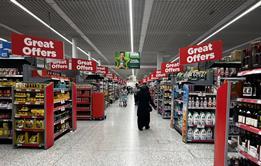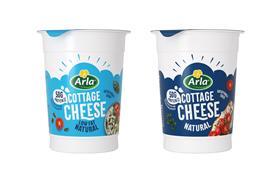After months of preparation and speculation, the first tranche of HFSS rules has officially arrived. Stores will now be legally required to adhere to rules on the display of high fat, salt and sugar (HFSS) products. Here’s everything you need to know about the immediate – and future – changes.
1. What will be the immediate changes?
From today (1 October), stores will be legally obliged to limit where they display HFSS foods and drinks. Items cannot appear in any area within two metres of the checkout or a queuing facility. They are also banned from promotional locations: at the end of aisles, store entrances or a covered external area, such as the lobby. The idea is to limit impulse purchases of these items, which will be largely confined to in-aisle displays.
This does throw up some complexities, though. For example, HFSS items can be displayed in-aisle within two metres of a checkout facility or a designated queuing area – just not on the end of an aisle and or on an island-type structure within two metres of those areas. There is also a mathematical formula to determine how closely stores are able to site HFSS products to their entrances. But as a broad rule, they should not be within 15 metres of the midpoint of the entrance.
2. Will further HFSS restrictions come in?
The restrictions on display were only one strand of the proposed HFSS restrictions. Originally, these were due to coincide with bans on multibuy deals, ads on TV before 9pm and paid-for ads online. However, these elements were delayed in May due to concerns over the cost of living crisis – an argument many have challenged. These additional restrictions could be axed permanently, though, if Liz Truss gets her way and adds them to her bonfire of red tape. Earlier this week, rumours circled over a full abandonment of the plans – something that Labour has said it wouldn’t reverse. So for now, it’s anyone’s guess whether further restrictions will come to fruition.
3. Which businesses are in the scope of the rules?
All retail businesses selling food and drink will be subject to the HFSS rules. But there are some important exceptions. For example, the government has exempted “micro or small businesses” – those with under 50 employees – from the restrictions. This would, in theory, cover many convenience stores. However, government guidance also stipulates the inclusion of franchises and symbol group stores. This has prompted debate over the position of small stores that belong to a symbol group.
It’s also worth noting concessions are exempt from the rules, too. So in theory, a confectionery concession could set up stall at the entrance of a supermarket without falling foul of the law.
4. Which products are the scope of the rules?
The Nutrient Profiling Model, which awards positive and negative points for different nutrients, is used to determine which products are classed as HFSS. A food is classified as ‘less healthy’ if it scores four points or more, and a drink is classified as ‘less healthy’ if it scores one point or more.
However, not all foods and drinks are subject to the regulation. The HFSS rules only apply to the following broad categories:
- Prepared soft drinks containing added sugar ingredients
- Savoury snacks
- Breakfast cereals
- Confectionery including chocolate and sweets
- Ice cream, including ice lollies, frozen yoghurt, water ices and similar frozen products
- Cakes and cupcakes
- Sweet biscuits and bars based on one or more of nuts, seeds or cereal
- Morning goods
- Desserts and puddings
- Yoghurt and fromage frais (sweetened with sugar or otherwise)
- Pizzas
- Chips and potato products
- Ready meals, meal centres and breaded and battered products
There are some exemptions within these categories. For example, nuts are not included within the scope of savoury snacks, while cheesy garlic breads are not included under ‘pizzas’. There remains some confusion over certain items, such as boxes of crackers.
5. How will the rules be enforced?
The enforcement of HFSS rules falls to local authorities i.e. county, borough or district councils, either through trading standards or environmental health officers. Each council will have a publicly available investigations and enforcement policy.
Stores that fail to comply will first be served with an improvement notice. If the issue is not resolved following that notice, it can result in criminally prosecution or a £2,500 penalty.
The use of local authorities to enforce the rules was one point raised by Kellogg’s in its legal challenge. Kellogg’s claimed the entire HFSS clampdown should be declared “ultra vires” – or ‘beyond the powers’ – because enforcement powers given to local authorities have never been approved by parliament.
6. What changes will happen in store?
Most stores have geared up for the legislation already, so there is unlikely to be much in the way of overnight changes. The major mults have all approached the display restrictions in different ways, as reported by IGD’s Bryan Roberts earlier this year.
For example, Asda, Morrisons and Sainsbury’s have been making the most of aisle space by using the final bay to house eye-catching promotions for HFSS lines. Tesco and Waitrose, meanwhile, appear to be using bays further into the aisles.
The departure of HFSS lines from prominent spaces has also created opportunities for other categories. We’ve already seen healthier snacks – most recently exemplified by Boots rolling out dedicated new fixtures – alcohol, vapes and chewing gum making their way into key display areas.
7. Are the rules the same across the UK?
The spirit of the rules is the same across the UK – but, as always, there are some differences between devolved nations.
In Wales, the government is keen to go a few steps beyond the proposals in England. As well as restrictions on multibuys and other promotions on HFSS products, the Welsh proposals suggest HFSS items should be banned from temporary price reductions, as well as free standing display units. It also wants additional products, including cooking sauces, pasta with added ingredients and table sauces, to fall under the scope of the legislation.
Scotland similarly wants to push the legislation further with a ban on volume and location promotions, on top of temporary price promotions and meal deals (in England, HFSS items can still be part of a meal deal but cannot be displayed outside of the location restrictions).
Everything you need to know about HFSS but were afraid to ask

Despite last-minute rumours to the contrary, the HFSS rules are now live. It’s been a right upheaval. Are you up to speed?
- 1
- 2
- 3
- 4
- 5
- 6
- 7
- 8
 Currently
reading
Currently
reading
Seven key questions on the HFSS rules





































2 Readers' comments